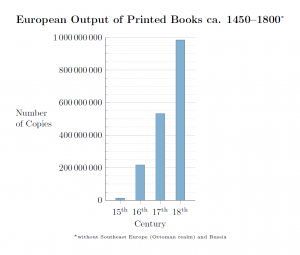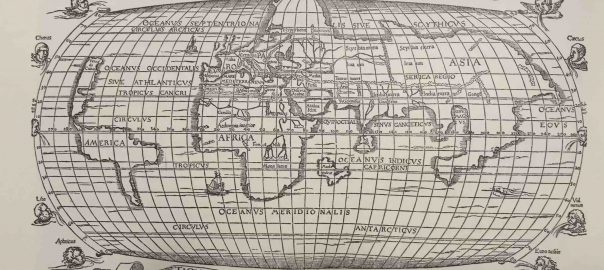1534 CE was a pretty interesting interesting year in the development of European-origined imperialism. Scroll on down for a quick visit to the history of printing. But here were the main global-political events of the year:
- In March, Portugal’s King John II established the first system to organize and promote permanent settlement and control in the interior of Brazil (then known as “Terra de la Santa Cruz”.) This project marked a break with the policy Portugal had been pursuing for c. 100 years in the broad trading empire it had built around the Indian Ocean and looked much more like the active settler colonialism the Spanish had been pursuing in South and Central America in recent decades. The new Portuguese system was called “Captaincies”. The 15 captaincies were mainly drawn as east-west stripes of land, running westwards from the Atlantic coast to the Tordesillas Line (where Spanish territory began). Five were awarded to two cousins of the finance minister: the conquistador Martim Afonso de Sousa and his brother. The others were granted to a mix of conquistadores and court bureaucrats.
- In April, the Breton/French explorer Jacques Cartier, who had married money, received a commission from the French king to sail to the north of the American continent in the continuing quest to find a “northwestern passage” to the Indian Ocean. Instead, between May and July he “discovered” Newfoundland, the Gulf of St. Lawrence, Gaspé Bay, Prince Edwards Island, etc. Guess what? He encountered some native people, most likely Mi’kmaq. English-WP tells us “some trading occurred.” He would come back in later years!
- In December, England’s Reformation Parliament passed the Act of Supremacy establishing Henry VIII as supreme head of the Church of England. (Sounds a bit like Boris Johnson’s act of secession?)
- Also in December, conquistador Sebastián de Belalcázar led 200 Spanish settlers in the founding of the settler-city that became Quito, Ecuador.
- At some point in 1534 CE, month unknown, Suleiman the Magnificent, having turned his attention from Central Europe to West Asia, captured Baghdad from the Safavids.
- Across France and Germany, religious tensions continued to roil. There were insurgencies of Anabaptists (in Germany) and Huguenots (in France.) But there was also the founding of the Jesuit order in Paris.
- In Ming China, imperial forces captured a pirate with more than 50 ships under his command. The Jiajing Emperor also somewhat mysteriously started to stay away from attending state meetings, though his ministers continued to run the empire more or less as usual. He seems rather a nasty chap. English-WP tells us: “His pursuit of eternal life led him to believe that one of the elixirs of extending his life was to force virgin palace maids to collect menstrual blood for his consumption. These arduous tasks were performed non-stop even when the palace maids were taken ill and any unwilling participants were executed on the Emperor’s whim.”
- Martin Luther’s translation into German of the whole Bible (including the Apocrypha) was printed by a Hans Lufft in Wittenberg. Size of print run not given.
A quick look at the history and role of printing
Okay, I confess upfront that I’ve never read Jared Diamond’s influential 1997 book “Guns, Germs, and Steel” that sought to explain the emergence and maintenance of the West’s domination of the world through its command of those three key baskets of commodities. (I believe his reference to “germs” was more a reference to Westerners having developed immunities to certain pathogens rather than to the almost certainly valid supposition that Western “explorers” on occasion actively used biological-warfare means to exterminate or weaken subject population.) Anyway, I would like to add three key other technological capabilities to the list of empire-critical capabilities: shipbuilding, navigational abilities, and movable type.
So I’ve started to be struck already in the 14 days I’ve been doing this “Project 500 Years” to see the role that print materials and printing capabilities played in helping foster the emergence of Western imperialism. Benedict Anderson is rightly famous for having identified “print capitalism” as having been an essential factor in the development of “nation-states.” But in this earlier era of the early 16th century CE, we hadn’t yet seen the emergence of any stably settled nation-states in Europe except those of Portugal and perhaps Spain– the stabilization of both of which had been largely due to the need to organize and regulate the exploits of their respective bands of conquistadores. For what it’s worth, I am definitely heading toward the conclusion that the emergence of stably settled nation-states in all of Europe was largely a consequence of imperialism, rather than an antecedent to it… (Also, that these states formed the nations, rather than the other way round.)
Be that as it may. It’s also worth examining the role that technological development in the printing sector played in supporting (and helping to maintain sufficient consent for!) the projects of Western empire-builders. I’m thinking of three particular types of print product:
- Navigational maps essential to safe navigation of distant waters, and their compilation into atlases.
- Explorers’ accounts of their findings, in which they systematically catalogued the things they found in distant lands that might be of value, and also described local flora, fauna, and folkways in ways that would excite interest and the desire to “own”, experience, or on many occasions vanquish those manifestations of life (including human life) on distant shores.
- Religious and other forms of ideological tracts that would be used to justify Christian/Western domination of the whole world.
 So here at right is a fab chart, produced by Tentotwo, showing the explosion in the European output of print books between 1450 and 1800 CE. The output jumped from around 1.5 million copies produced in the 15th century to more than 200 million in the 16th century, and continued to soar even higher in the next two centuries.
So here at right is a fab chart, produced by Tentotwo, showing the explosion in the European output of print books between 1450 and 1800 CE. The output jumped from around 1.5 million copies produced in the 15th century to more than 200 million in the 16th century, and continued to soar even higher in the next two centuries.
If Martin Luther had just sat at home translating the Bible, or had relied on a small group of friends to hand-copy his translations, his work would never have had the kind of impact across the whole continent that it undoubtedly had.
So one of the key innovations of early-imperialism/ early-capitalism had been the development and speedy spread of movable type. English-WP tells us that though it’s generally surmised that movable type was developed by Joannes Gutenberg in Mainz, around 1439 CE, actually earlier forms of movable type had been developed in Northern China, under the Northern Song dynasty in around 1041 CE. Fascinating! So the world can thank China for that invention along with such other inventions as gunpowder, paper, and distilled spirits!
It turned out that movable type was pretty hard to get widely accepted in China itself, because of the plethora and complexity of its ideograms. (The use of printing from carved woodblocks was, however, so widespread in China that when Italian Jesuit Matteo Ricci reached there in the late 16th century he made note of “the exceedingly large numbers of books in circulation here and the ridiculously low prices at which they are sold.”)
In Europe, however, the introduction of movable type was transformational. One of the things it powered was, as Anderson had noted, the development of nation-states. Another (perhaps antecedently to, but certainly hand-in-hand with, the development of nation-states) was the development of empires.
Movable type really helped speed the dissemination of texts! But woodblock printing continued to be used for maps and other illustrations. The map of the whole known world at the top here was engraved in 1534 CE by (or for) the geographer Joachim van Watte and published in Zurich.
